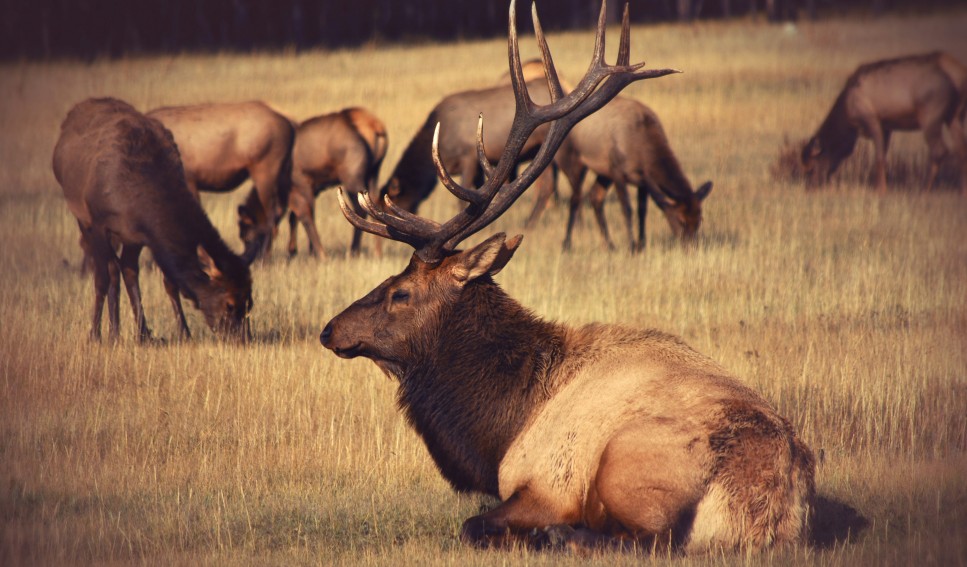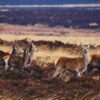Elk, magnificent wild animals, are characterized by specific actions, one of which is wallowing. But many questions about this practice remain unanswered though it is particularly related to these animals. Do elk always wallow? What role does it play, particularly in late Summer during the rutting period?
Reference to the frequency, condition that leads to it, and relationship with sexual activity: In this blog, we are going to explain what it is to be an elk wallowing. We will also touch on favorite feeding grounds, other signs of wallow use, and other general guidelines for hunting these majestic creatures.
What Is Elk Wallowing?
Mud-wallowing is a behavior that involves rolling in the mud or lying on the ground and making conical or shallow bowls of water and mud, known as wallows. Both sexes of elks are known to wade, although the term wallowing more usually refers to bulls (males) during the rutting season.
The primary purpose of wallowing during the rutting season is mating success. Bulls engage in wallowing to attract cows by amplifying their scent with pheromones, display their fitness and readiness to mate, and establish dominance over competing bulls in the area.
Why Do Elk Wallow?
Elks roll in mud for several reasons, including:
- Scent Marking During the Rut: Bulls roll in the wallow, coating themselves with their scent while urinating in the wallow. This pheromone-rich mud is used as a signal to cows (female elk) that it’s time to mate.
- Territorial Display: Wallowing is a means that bulls use to intimidate rivals, showing their power through scent and muddy appearance.
- Cooling Off: Wallowing helps to cool elk during warm weather, especially when water sources are limited.
- Parasite Control: The mud eases the irritation that external parasites such as ticks and flies can cause the elk.
- Social Communication: Wallowing lets other elk learn about a bull’s size, health, and dominance through scent.
Do Elk Always Wallow?
No, elk do not always wallow. Laying in water and mud is reactive and only occurs during the rut, certain environmental conditions such as warm temperatures, and when water and mud are accessible.
Males wallow only during the rut whereas females and young of both sexes may engage in this activity occasionally but not so frequently or for the same purpose as bulls.
Frequency and Conditions for Elk Wallowing
The frequency of wallowing varies depending on:
- Season: Wallowing is most frequent during the rut (Late Summer to Early Fall) as bulls use it for scent marking and attracting mates. While, wallowing may occur sporadically and primarily for cooling or relieving irritation from parasites.
- Environment and Habitat: Elk in areas with abundant water sources may wallow more frequently as wallows are easier to create.In drier habitats, wallowing might be less frequent or occur only after rainfall or near limited water sources.
- Time of Day: Elk often wallow during cooler parts of the day, such as early morning or late afternoon, to avoid overheating.
Factors Influencing Wallowing Behavior
- Seasonal Hormonal Changes: In the rut, increasing testosterone levels in bulls stimulate them and they have to start wallowing for scent marking and showing dominance.
- Availability of Water Sources: There should be access to water or mud in close range. Thus, much less will be done by the elk from arid areas because access to water bodies is limited, and hence less opportunity is available for them to do this. Weather conditions like rainfall provide more wallowing by making the ground wet and muddy.
- Temperature and Weather: Warm periods promote wallowing as a form of keeping cool when temperatures are high. However, the possible rise in environmental temperature might minimize this behavior apart from the breeding period.
- Social Dynamics: Inter– and intrasexual competitors may also be stimulating wallowing, for example, the presence of other bulls or cows in their vicinity for challenge or mating purposes.
- Parasites and Skin Irritation: Elk may wallow to alleviate the irritation caused by ticks, flies, or other skin irritants, particularly in the summer.
Elk Mating Season Behavior
The elk rut itself takes place largely from late summer into early fall but peaks sometime in September. Bulls (male elk) compete savagely with other bulls for cows’ (female elk) attention during this period.
During the rut, bulls are extremely vocal, making loud bugling calls to assert dominance and attract a mate. The area during the rut is a critical time for reproduction and during this time elk behave differently.
Role of Wallowing in Mating Season
- Scent Marking: Bulls wallow in mud, urine, and pheromones to spread information about their presence and their status, to the cows. This scent acts as an attractant for the most dominant and fit-looking bulls, when they may come to the wallows to attract females.
- Dominance Display: Even the look and smell of a mud-covered bull is an indicator of other bulls. It is meant to show that the bull is fit and strong and in control of the whole social hierarchy.
- Attracting Cows: It is to distract the cows and their focus from him by leaving a trail of scent in the wallows and through the bull’s behavior.
Elk Mating Behavior Overview
In addition to wallowing, elk also has several other mating behaviors during the rut:
- Bugling: Bulls use bugling, a loud and high-pitched call, that is also used by bulls to let other bulls know who has the most power and to attract cows. However, it also warns rival bulls off and helps mark territory.
- Fighting and Sparring: Bulls fight using their antlers to spar with other bulls. These are fights to see which bull is the strongest and best of males to mate with females. The right to mate with the females in the area is the winner.
- Herding Cows: Once he has drawn a bunch of females a dominant bull will get these girls together keeping close and defending them from competing bulls. He will guard his harem and will try to stop other bulls from coupling to the cows.
- Chasing Rival Bulls: Bulls may chase and fight aggressively with other bulls to try to dominate them and assert their territory. Physical aggression, displays of strength, and vocalizations are all ways that such physical interaction can occur.
- Mating Rituals: Inconsistencies regarding courtship behavior even once a bull has claimed dominance and attracted a cow include nuzzling and following the female closely.

image from Rocky Mountain Elk Foundation
Where Can I Find Elks?
North America is where elk are found, with small populations happening in regions of Asia.
The range of the species in North America includes the western United States, Canada, and northern Mexico. The following regions are typical for elk:
- Rocky Mountains: One of the most abundant areas for elk, including states like Wyoming, Montana, Colorado, and Idaho.
- Pacific Northwest: Elk are commonly found in forests and mountainous areas of Washington, Oregon, and Northern California.
- Appalachian Mountains: Elk have been reintroduced in parts of Kentucky, Tennessee, and West Virginia.
- Northern Plains: Elk also inhabit grasslands, especially near the Canadian border in states like North Dakota and parts of Canada.
Where Is The Typical Habitats of Elk?
Elk are adaptable and can live in a variety of habitats, including:
- Forests and Woodlands: Elk are often found in coniferous and mixed forests during the winter, where they can find shelter and food like grasses, shrubs, and trees.
- Mountainous Areas: Elk thrive in the mountainous regions, often in alpine meadows during summer, where they graze on grasses and forage for food.
- Grasslands and Meadows: During the warmer months, elk are frequently found in open meadows, where they feed on grasses and other vegetation.
- Riparian Zones: Elk are drawn to areas near streams, rivers, and lakes, especially during the rut and warmer months, where they can find water and mud for wallowing.
What Are Some Specific Signs of Elk Wallowing Activity?
To identify potential elk sites, look for these signs of elk wallowing activity:
Mud and Dirt Depressions: Shallow depressions in the ground churned up and coated with mud are common wallowing areas. They may have visible tracks in these areas or footprints.
Mud-Covered Vegetation: You may notice crushed or bent vegetation around it, such as grasses, plants, or small shrubs which elk may roll in, but trample or break.
Scent Trails: Elk marks the wallow by leaving strong musky odors and urine around the wallow; if you are sitting near the wallow, the odor will be strong as well as musky.
Antler Rubs: As part of their dominance display bulls may rub their antlers against nearby trees or shrubs. You should find some shredded tree bark or scuffed trunks near wallow sites.
Hair and Fur: Rolling in the mud may leave elk hair on the edge of the largest part of the wallow, and bullwallowing sites may have walls that include elk hair.
How to Find Potential Wallowing Sites?
Finding wallowing sites and planning elk hunts requires knowledge of elk behavior and the terrain they prefer. Here are some strategies:
- Look for High-Traffic Areas: Wallowing sites are often located near water sources like streams, ponds, or mud flats. Elk will typically wallow in areas with easy access to water but also sufficient cover, such as dense forests or meadows.
- Focus on Rutting Grounds: During the rut, elk are more likely to wallow to mark their territory. Look for areas where bulls are active, which are often open meadows near forests or riparian zones where elk have access to mud and water.
- Track Signs: Follow elk tracks and signs of fresh droppings that lead you to wallowing areas. Bulls will often leave a trail of disturbed vegetation and mud as they move toward their wallows.
- Study Elk Behavior Patterns: Elk wallow more frequently during the early morning and late afternoon. Try scouting these times to observe the bulls or track their movements.
- Use Trail Cameras: Set up trail cameras around suspected wallow areas to monitor elk activity. This can help you identify the best times for hunting and where elk are most active.
- Pay Attention to Terrain: Elk prefer areas with a good mix of open feeding areas and dense cover for protection. Identify elevated ridges, mountain passes, or valleys near water sources where elk might frequent.
- Hunt Close to Wallowing Areas: Plan your hunt by setting up near these wallowing sites, especially if you know that bulls are using the area during the rut. Stay downwind to avoid detection and use natural cover to stay hidden.

How to Hunt Elk Near Wallows?
Hunting elk near wallows requires a strategic approach, as these areas are often where bulls congregate to mark territory and attract mates.
When Is The Best Time to Find Elk?
- Rut (Late Summer to Early Fall)
The best time to hunt elk near wallows is during the rutting season when bulls are actively marking territory and attracting cows. The rut peaks in September, but bulls may start wallowing in late August.
- Early Morning and Late Afternoon
Elk are more likely to visit wallows during the early morning (just after sunrise) and late afternoon (before sunset). These times offer cooler temperatures, and elk tend to be more active during these hours.
- After Rainfall
Elk may wallow more frequently after rainfall, as the wet soil creates ideal conditions for wallowing. Rain also makes it easier for elk to detect scents, making them more likely to be near wallows.
Hunting Tips for Hunters Near Wallow Sites
- Know Elk Travel Patterns
Wallows are usually the endpoint for defined travel corridors for elk. Look at the ridges, saddles, and valleys elk use to get from feeding to water sources. Before the hunt, spend time scouting the area around known wallows to identify elk activity. Look for fresh signs like hoof prints, mud tracks, and hair on vegetation around the wallow.
- Use Cover and Concealment
Elk have really good vision and hearing. If you’re watching or stalking the wallow, use trees, brush, and natural terrain to your advantage. Wearing camouflage clothes is also a great way to blend in with the environment.
- Be Aware of Your Scent
Aside from wearing scent removal products and scents, I also suggest masking the human scent with cover scents. Do not wear anything that has a strong scent (e.g., perfumes or deodorants that have a scent in them, or food). Position yourself downwind of the wallow, so the elk won’t catch your scent. Be mindful of prevailing winds and use natural terrain like hills or trees for cover.
- Use a Decoy or Calls
During the rut, elk calls (especially bugles and cow calls) can be highly effective. Bugling can attract bulls by mimicking a rival bull, while cow calls can draw in cows looking for a mate.
Bulls will frequently respond to elk decoys during the rut. Place decoys with calls to present a cow or another bull – this should attract elk closer to the wallow.
- Hunt the Edges of the Wallow
Elk can be a bit cautious when coming to a wallow, so it is usually best to hunt from the edge instead of over the wallow itself. In place along nearby trails, or feeding grounds, where elk are likely to pass by to or from the wallow.
- Don’t Overhunt the Area
Elks are smart and they are also easily spooked. Don’t over-hunt your wallows by keeping at it after a few misses or unsuccessful attempts. If they see you too frequently or often enough, elk may be wary.
- Stay Quiet and Keep Your Distance
Hunt near wallow always quietly and patiently. If elk come up and get close, do not do things suddenly. Be ready to take a shot and only when you have a clean and ethical shot.
Conclusion
Elk certainly wallows; especially during the rut. Other such uses include scent marking, dominance display, cooling, and parasite control. Wallowing is not a constant behavior, but it’s a hugely important part of elk life, especially when it comes to mating season.
Hunters need to understand this behavior, not only to know which prime elk location to hunt but also to give themselves the best chance of success.




















Leave a reply